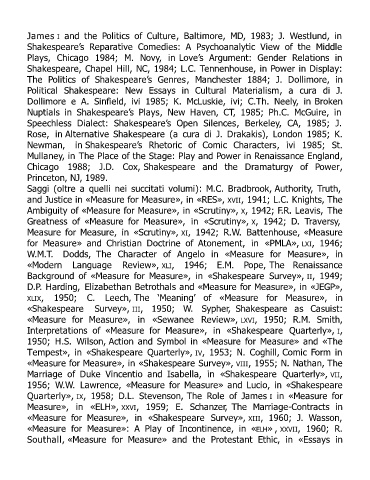Page 945 - Shakespeare - Vol. 3
P. 945
James I and the Politics of Culture, Baltimore, MD, 1983; J. Westlund, in
Shakespeare’s Reparative Comedies: A Psychoanalytic View of the Middle
Plays, Chicago 1984; M. Novy, in Love’s Argument: Gender Relations in
Shakespeare, Chapel Hill, NC, 1984; L.C. Tennenhouse, in Power in Display:
The Politics of Shakespeare’s Genres, Manchester 1884; J. Dollimore, in
Political Shakespeare: New Essays in Cultural Materialism, a cura di J.
Dollimore e A. Sinfield, ivi 1985; K. McLuskie, ivi; C.Th. Neely, in Broken
Nuptials in Shakespeare’s Plays, New Haven, CT, 1985; Ph.C. McGuire, in
Speechless Dialect: Shakespeare’s Open Silences, Berkeley, CA, 1985; J.
Rose, in Alternative Shakespeare (a cura di J. Drakakis), London 1985; K.
Newman, in Shakespeare’s Rhetoric of Comic Characters, ivi 1985; St.
Mullaney, in The Place of the Stage: Play and Power in Renaissance England,
Chicago 1988; J.D. Cox, Shakespeare and the Dramaturgy of Power,
Princeton, NJ, 1989.
Saggi (oltre a quelli nei succitati volumi): M.C. Bradbrook, Authority, Truth,
and Justice in «Measure for Measure», in «RES», XVII, 1941; L.C. Knights, The
Ambiguity of «Measure for Measure», in «Scrutiny», X, 1942; F.R. Leavis, The
Greatness of «Measure for Measure», in «Scrutiny», X, 1942; D. Traversy,
Measure for Measure, in «Scrutiny», XI, 1942; R.W. Battenhouse, «Measure
for Measure» and Christian Doctrine of Atonement, in «PMLA», LXI, 1946;
W.M.T. Dodds, The Character of Angelo in «Measure for Measure», in
«Modern Language Review», XLI, 1946; E.M. Pope, The Renaissance
Background of «Measure for Measure», in «Shakespeare Survey», II, 1949;
D.P. Harding, Elizabethan Betrothals and «Measure for Measure», in «JEGP»,
XLIX, 1950; C. Leech, The ‘Meaning’ of «Measure for Measure», in
«Shakespeare Survey», III, 1950; W. Sypher, Shakespeare as Casuist:
«Measure for Measure», in «Sewanee Review», LXVI, 1950; R.M. Smith,
Interpretations of «Measure for Measure», in «Shakespeare Quarterly», I,
1950; H.S. Wilson, Action and Symbol in «Measure for Measure» and «The
Tempest», in «Shakespeare Quarterly», IV, 1953; N. Coghill, Comic Form in
«Measure for Measure», in «Shakespeare Survey», VIII, 1955; N. Nathan, The
Marriage of Duke Vincentio and Isabella, in «Shakespeare Quarterly», VII,
1956; W.W. Lawrence, «Measure for Measure» and Lucio, in «Shakespeare
Quarterly», IX, 1958; D.L. Stevenson, The Role of James I in «Measure for
Measure», in «ELH», XXVI, 1959; E. Schanzer, The Marriage-Contracts in
«Measure for Measure», in «Shakespeare Survey», XIII, 1960; J. Wasson,
«Measure for Measure»: A Play of Incontinence, in «ELH» , XXVII, 1960; R.
Southall, «Measure for Measure» and the Protestant Ethic, in «Essays in

